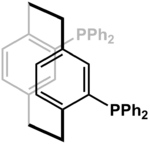Chemistry:Phanephos

| |
| Names | |
|---|---|
| IUPAC name
(S)-(+)-4,12-Bis(diphenylphosphino)-[2.2]-paracyclophane; (R)-(−)-4,12-Bis(diphenylphosphino)-[2.2]-paracyclophane
| |
| Other names
(S)-Phanephos; (R)-Phanephos
| |
| Identifiers | |
| |
3D model (JSmol)
|
|
| ChemSpider |
|
| EC Number |
|
PubChem CID
|
|
| |
| |
| Properties | |
| C40H34P2 | |
| Molar mass | 576.660 g·mol−1 |
| Appearance | White to off-white powder or crystals |
| Melting point | 222 to 225 °C (432 to 437 °F; 495 to 498 K) |
Except where otherwise noted, data are given for materials in their standard state (at 25 °C [77 °F], 100 kPa). | |
| Infobox references | |
Phanephos is an organophosphorus compound with the chemical formula (C2H4)2(C6H3PPh2)2 (Ph = C6H5). It is a white solid that is soluble in organic solvents. It is an example of a chiral C2-symmetric diphosphine ligand used in asymmetric hydrogenation. Many substituents have been introduced in place of the phenyl groups, e.g., i-Pr, C6H11, etc and a variety of chiral diphosphine ligands have been reported in asymmetric catalysis since the 1960s.
Preparation
Phanephos can be prepared in two steps from [2.2]paracyclophane. In the first step, [2.2]paracyclophane is dibrominated to give a pseudo-para dibromide. Thermal isomerisation then gives pseudo-ortho atropisomer of the dibromide. This isomer is subjected to lithium-halogen exchange by nBuLi and the resulting dilithium compound is treated with PPh2Cl to give a racemic mixture of Phanephos.[1]
Uses
Phanephos has been used in rhodium- and ruthenium- mediated stereoselective hydrogenation of dehydro amino acid methyl esters and asymmetric reduction of various β-ketoesters with about 90% ee.[2]
References
- ↑ G. J. Rowlands, Planar Chiral Phosphines Derived from [2.2]Paracyclophane , Israel Journal of Chemistry, 2012, 52. 60-75, doi: 10.1002/ijch.201100098
- ↑ R. Gleiter, H. Hopf, Modern Cyclophane Chemistry, Wiley-VCH Verlag GmbH & Co. KGaA, 2005, p.449-451 doi: 10.1002/3527603964
 |


